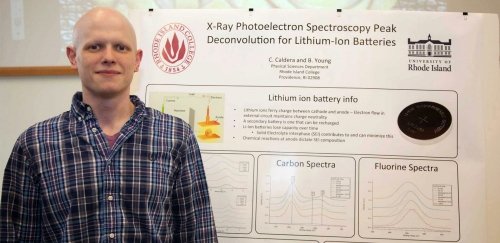One of the Hottest Research Topics in the World – Batteries
- News & Events
- News
- One of the Hottest Research Topics in the World – Batteries

RIC physics major Christopher Caldera
Companies all over the world, including General Electric, Aquion Energy and Sonnenbatterie, are investing millions in research to improve the performance of lithium-ion batteries for longer-lasting, financially viable electric cars, smartphones and renewable energy in the home.
In an independent honors research project, Chris Caldera ’15, a physics major, worked closely with RIC Assistant Professor of Physics Benjamin Young, whose work in battery research, funded by DOE-EPSCoR, began when Young was a Ph.D. student at URI. At RIC, Young continues to collaborate with URI on this project.
After working for a semester with Young, Caldera discussed the results of his project at a RIC poster session attended by faculty, administrators and students.
Caldera first pointed out that before the lithium battery itself can be improved, battery researchers have to improve their research methods. “No one is there yet,” he said, “which is why my project focused on the research methodology.”
With a battery, he said, you’re trying to convert chemical energy to electrical energy through a chemical reaction. For a rechargeable battery, that chemical reaction needs to be reversible.
When a lithium-ion battery is recharged over time it loses much of its recharge capacity. The reason for this, he said, is that “some of the material within the battery that is going through a chemical reaction, reacts permanently and that reaction cannot be reversed. This is usually due to oxidation.”
However, there are materials that can minimize oxidation. That material helps to form the battery’s solid electrolyte interphase (SEI). The SEI is something that always forms on a rechargeable battery the first time it is recharged. More importantly, the SEI is what stops the material in the battery from breaking down.
The goal of battery researchers is to build a battery out of the same materials found in the SEI, that is, materials that will minimize oxidation and increase the battery’s ability to recharge for a longer period of time.
The first step is to find out what materials/elements are in the SEI of a high-performing battery. To do that, Young and Caldera used a measuring device called the XPS (X-ray Photoelectron Spectroscopy) machine.
“The XPS machine detects the binding energy – a property of the element itself – and the intensity – how much of a particular element is present – and prints it out in a spectra of peaks,” Caldera explained.
“XPS spectra for simple compounds are straightforward to analyze, but the SEI has many compounds and those spectra are challenging to pick apart,” said Young. “Although many people use XPS to study the SEI, we aim to do it quantitatively, with results that are reproducible and more reliable than the current standard.”
Impressed with Caldera’s results, Young noted that “Chris was able to predict the spectra of mixtures fairly well.” He said the future goal is to collect enough data on individual compounds that researchers know are present in the SEI of a high-performing battery and model the amounts of those compounds in the SEI of a new and improved battery of the future.
Since graduating in May, Caldera intends to move on to do graduate work in another hot branch of physics – physical cosmology.
